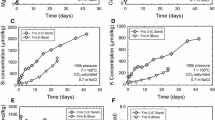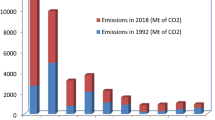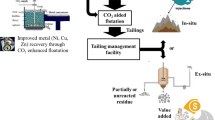Abstract
For geological carbon sequestration, the reaction of aqueous CO2 with silicate rock permits carbonate formation, achieving permanent carbon sequestration. The fractures available in silicate rock provide significant surface area for the precipitation of carbonates. The experiments were performed in a batch tubular reactor under diffusion-limited condition, with a special arrangement of a narrow tube filled with a 2800 g/L dunite slurry. The tube was kept open from the top, standing vertically filled with a CO2-rich bulk solution under 1 barg CO2 and temperatures ranging from 25 to 75 oC for 7–30 days. After 7 days of the experiment, magnesite precipitation was seen inside the tube and the precipitation was continued for up to 30 days. The magnesite precipitation was identified by micro-Raman spectroscopy, X-ray diffraction, and scanning electron microscopy. Additionally, SiO2 formation was seen in relative close vicinity to the magnesite precipitation. The precipitation on the surface of silicate rock might cover the fractures and pore spaces available, which may over time reduce the dissolution rate of dunite.

Graphical Abstract






Similar content being viewed by others
Notes
In principle, monovalent (Na) cations would also work, though the much higher solubility of their carbonates makes them less practical
Close system in gas and other chemicals cannot escape to the atmosphere Where the gas can escape to the atmosphere
Ideally for olivine, the molecular composition of Mg and Fe should add up to 2, as in the ratio between two-valent cations and Si of 2 (or be slightly less if their are some minor impurities not listed).
In other silicates that ratio is either equal or lower than 2.
My best guess is that there is Mg and/or Fe present that is not in the form of a silicate (possibly oxide or hydroxide). Could you try to expand on aspect?
I am also not sure how the elemental composition in Table 1 can be related to the molecular formula.
Reason of the high ratio has been postulated It may be because of possible presence of Fe in the form of oxide or hydroxide. However the hypothesis cannot be verified at this stage as the experimental sample has been discarded.
Concentrated slurry means fixed bed of solid particles saturated with water.
References
Alexander G, Mercedes Maroto-Valer M, Gafarova-Aksoy P (2007) Evaluation of reaction variables in the dissolution of serpentine for mineral carbonation. Fuel 86:273–281. https://doi.org/10.1016/j.fuel.2006.04.034
Andreani M, Luquot L, Gouze P, Godard M, Hoisé E, Gibert B (2009) Experimental Study of Carbon Sequestration Reactions Controlled by the Percolation of CO2 -Rich Brine through Peridotites. Environ Sci Technol 43:1226–1231. https://doi.org/10.1021/es8018429
Assayag N, Matter J, Ader M, Goldberg D, Agrinier P (2009) Water–rock interactions during a CO2 injection field-test: Implications on host rock dissolution and alteration effects. Chem Geol 265:227–235. https://doi.org/10.1016/j.chemgeo.2009.02.007
Bachu S (2000) Sequestration of CO2 in geological media: criteria and approach for site selection in response to climate change. Energy Convers Manag 41:953–970. https://doi.org/10.1016/S0196-8904(99)00149-1
Bachu S, Adams JJ (2003) Sequestration of CO2 in geological media in response to climate change: capacity of deep saline aquifers to sequester CO2 in solution. Energy Convers Manag 44:3151–3175. https://doi.org/10.1016/S0196-8904(03)00101-8
Balucan RD, Dlugogorski BZ, Kennedy EM, Belova IV, Murch GE (2013) Energy cost of heat activating serpentinites for CO2 storage by mineralisation. Int J Greenh Gas Control 17:225–239. https://doi.org/10.1016/j.ijggc.2013.05.004
Béarat H, McKelvy MJ, Chizmeshya AVG et al (2006) Carbon Sequestration via Aqueous Olivine Mineral Carbonation: Role of Passivating Layer Formation. Environ Sci Technol 40:4802–4808
Chopelas A (1991) Single crystal Raman spectra of forsterite, fayalite, and monticellite. Am Mineral 76:1101–1109
Daval D, Sissmann O, Menguy N, Saldi GD, Guyot F, Martinez I, Corvisier J, Garcia B, Machouk I, Knauss KG, Hellmann R (2011) Influence of amorphous silica layer formation on the dissolution rate of olivine at 90°C and elevated PCO2. Chem Geol 284:193–209. https://doi.org/10.1016/j.chemgeo.2011.02.021
Edwards HGM, Villar SEJ, Jehlicka J, Munshi T (2005) FT–Raman spectroscopic study of calcium-rich and magnesium-rich carbonate minerals. Spectrochim Acta Part A Mol Biomol Spectrosc 61:2273–2280. https://doi.org/10.1016/j.saa.2005.02.026
Ellis B, Peters C, Fitts J, Bromhal G, McIntyre D, Warzinski R, Rosenbaum E (2011) Deterioration of a fractured carbonate caprock exposed to CO2 -acidified brine flow. Greenh Gases Sci Technol 1:248–260. https://doi.org/10.1002/ghg.25
Felmy AR, Qafoku O, Arey BW, Hu JZ, Hu M, Todd Schaef H, Ilton ES, Hess NJ, Pearce CI, Feng J, Rosso KM (2012) Reaction of water-saturated supercritical CO2 with forsterite: Evidence for magnesite formation at low temperatures. Geochim Cosmochim Acta 91:271–282. https://doi.org/10.1016/j.gca.2012.05.026
Gebrehiwet T, Guo L, Fox D, Huang H, Fujita Y, Smith R, Henriksen J, Redden G (2014) Precipitation of calcium carbonate and calcium phosphate under diffusion controlled mixing. Appl Geochemistry 46:43–56. https://doi.org/10.1016/j.apgeochem.2014.04.005
Haenchen M, Prigiobbe V, Baciocchi R, Mazzotti M (2008) Precipitation in the Mg-carbonate system - effects of temperature and CO2 pressure. Chem Eng Sci 63:1012–1028
Hövelmann J, Austrheim H, Beinlich A, Anne Munz I (2011) Experimental study of the carbonation of partially serpentinized and weathered peridotites. Geochim Cosmochim Acta 75:6760–6779. https://doi.org/10.1016/j.gca.2011.08.032
Hövelmann J, Austrheim H, Jamtveit B (2012) Microstructure and porosity evolution during experimental carbonation of a natural peridotite. Chem Geol 334:254–265. https://doi.org/10.1016/j.chemgeo.2012.10.025
Huijge WJJ, Comans RNJ (2003) Carbon dioxide sequestration by mineral carbonation.
Indian Bureau of Mines (2015) Dunite & Pyroxenite, Indian Minerals Yearbook 2013 (Part- III : Mineral Reviews), 52nd edn. Nagpur
IPCC (2005) IPCC special report on carbon dioxide capture and storage. Energy 363–379.
Kelemen PB, Matter J (2008) In situ carbonation of peridotite for CO2 storage. Proc Natl Acad Sci 105:17295–17300
Kelemen PB, Matter J, Streit EE, Rudge JF, Curry WB, Blusztajn J (2011) Rates and mechanisms of mineral carbonation in peridotite: natural processes and recipes for enhanced, in situ CO2 capture and storage. Annu Rev Earth Planet Sci 39:545–576
Koljonen T, Siikavirta H, Zevenhoven R, Savolainen I (2004) CO2 capture, storage and reuse potential in Finland. Energy 29:1521–1527. https://doi.org/10.1016/j.energy.2004.03.056
Kump LR, Brantley SL, Arthur MA (2000) Chemical weathering, atmospheric CO2, and climate. 28:611–667. https://doi.org/10.1146/annurev.earth.28.1.611
Kwak JH, Hu JZ, Hoyt DW, Sears JA, Wang C, Rosso KM, Felmy AR (2010) Metal carbonation of forsterite in supercritical CO2 and H2O using solid state 29 Si, 13 C NMR spectroscopy. J Phys Chem C 114:4126–4134. https://doi.org/10.1021/jp1001308
Le Treut H, Cubasch U, Ding Y et al (2007) Historical overview of climate change science. IPCC Rep. 42:1293–1302. https://doi.org/10.1016/j.soilbio.2010.04.001
Liu Z, Zhao J (2000) Contribution of carbonate rock weathering to the atmospheric CO2 sink. Environ Geol 39:1053–1058. https://doi.org/10.1007/s002549900072
Matter JM, Kelemen PB (2009) Permanent storage of carbon dioxide in geological reservoirs by mineral carbonation. Nat Geosci 2:837–841. https://doi.org/10.1038/ngeo683
Mohanan K, Sharma SK, Bishop FC (1993) A Raman spectral study of forsterite-monticellite solid solutions. Am Mineral 78:42–48
Oelkers EH, Gislason SR, Matter J (2008) Mineral carbonation of CO2. Elements 4:333–337
Olivier JGJ, Janssens-Maenhout G, Muntean M, Peters JAHW (2014) Trends in global CO2 emissions: 2014 Report.
Pacala S, Socolow R (2004) Stabilization wedges: solving the climate problem for the next 50 years with current technologies. Science 305:968–972
Prieto M, Fernández-Diaz L, López-Andrés L, López-Andrés S (1989) Supersaturation evolution and first precipitate location in crystal growth in gels; application to barium and strontium carbonates. J Cryst Growth 98:447–460. https://doi.org/10.1016/0022-0248(89)90161-9
Prieto M, Fernández-Diaz L, López-Andrés S (1991) Spatial and evolutionary aspects of nucleation in diffusing-reacting systems. J Cryst Growth 108:770–778. https://doi.org/10.1016/0022-0248(91)90259-8
Putnis A, Prieto M, Fernandez-Diaz L (1995) Fluid supersaturation and crystallization in porous media. Geol Mag 132:1–13. https://doi.org/10.1017/S0016756800011389
Qafoku O, Hu J, Hess NJ, Hu MY, Ilton ES, Feng J, Arey BW, Felmy AR (2014) Formation of submicron magnesite during reaction of natural forsterite in H2O-saturated supercritical CO2. Geochim Cosmochim Acta 134:197–209
Sanna A, Hall MR, Maroto-Valer M (2012) Post-processing pathways in carbon capture and storage by mineral carbonation (CCSM) towards the introduction of carbon neutral materials. Energy Environ Sci 5:7781. https://doi.org/10.1039/c2ee03455g
Sanna A, Uibu M, Caramanna G, Kuusik R, Maroto-Valer MM (2014) A review of mineral carbonation technologies to sequester CO2. Chem Soc Rev 43:8049–8080. https://doi.org/10.1039/C4CS00035H
Sipilä J, Teir S, Zevenhoven R (2008) Carbon dioxide sequestration by mineral carbonation: Literature review update 2005 – 2007.
Van Noort R, Spiers CJ, Drury MR, Kandianis MT (2013) Peridotite dissolution and carbonation rates at fracture surfaces under conditions relevant for in situ mineralization of CO2. Geochim Cosmochim Acta 106:1–24. https://doi.org/10.1016/j.gca.2012.12.001
Wang F, Giammar DE (2012) Forsterite dissolution in saline water at elevated temperature and high CO2 pressure. Environ Sci Technol 47:168–173
Xiong W, Giammar D (2014) Forsterite carbonation in zones with transport limited by diffusion. Environ Sci Technol Lett 1:333–338. https://doi.org/10.1021/ez500182s
Yang L, Steefel CI, Bechtel H (2013) Microfuidic and capillary tube experimental study of forsterite carbonation by CO2 bearing uids. Am. Geophys. Union Fall Meet. Abstract V41A-2773
Yuen YT, Sharratt PN, Jie B (2016) Carbon dioxide mineralization process design and evaluation: concepts, case studies, and considerations. Environ Sci Pollut Res 23:22309–22330. https://doi.org/10.1007/s11356-016-6512-9
Zhang P, Anderson HL., Kelly JW., et al (2000) Kinetics and mechanisms of formation of magnesite from hydromagnesite in brine. Sandia National Laboratory: Albuquerque, NM, and Livermore, CA
Author information
Authors and Affiliations
Corresponding author
Additional information
Responsible Editor: Philipp Gariguess
Publisher’s note
Springer Nature remains neutral with regard to jurisdictional claims in published maps and institutional affiliations.
Electronic supplementary material
ESM 1
(DOCX 205 kb)
Rights and permissions
About this article
Cite this article
Agrawal, A.K., Mehra, A. Dunite carbonation in batch-tubular reactor. Environ Sci Pollut Res 27, 31439–31445 (2020). https://doi.org/10.1007/s11356-020-09426-4
Received:
Accepted:
Published:
Issue Date:
DOI: https://doi.org/10.1007/s11356-020-09426-4




